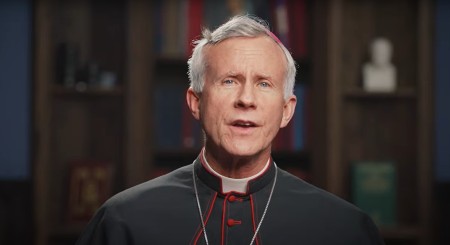The Happy Priest: Getting Ready for the New Mass Translation
FREE Catholic Classes
Highlights
Catholic Online (https://www.catholic.org)
9/25/2011 (1 decade ago)
Published in Living Faith
Keywords: Holy Mass, Revised Roman Missal, Liturgy, Divine Liturgy, Holy Sacrifice of the Mass, Fr James Farfaglia
CORPUS CHRISTI, TX (Catholic Online) - I am very excited that the new English translation of the ordinary form of the Roman Rite Catholic Mass will go into effect on November 27, the First Sunday of Advent.
The new English translation provides an excellent opportunity for a powerful liturgical renewal to take place within our parishes. An exceptional catechetical moment has arrived. So, beginning this Sunday, for the next weeks I will be delivering a series of six teaching sermons on the basics of the Catholic Mass and the new English translation.
I am more than confident that the new translation of the Novus Ordo Missae mandated by the Vatican document, Liturgiam authenticam, will return reverence to the Mass, sacredness to our music and beauty to our architecture.
Perhaps the biggest change that people will have to get accustomed to is the use of the literal translation of "Et cum spiritu tuo." Currently the priest or the deacon says: "The Lord be with you" and the people respond: "And also with you." With the new translation, the response is: "And with your spirit."
Jeffrey Pinyan, in his excellent book Praying the Mass: the Prayers of the People, points out that English is the only major language of the Roman Rite that did not translate the Latin word spiritu. For example, the Spanish "y con tu espiritu" is a precise translation of the Latin text.
Why is the difference between "with you" and "with your spirit" so crucial?
The literal translation of "Et cum spiritu tuo" as "And with your spirit" expresses precisely the essential difference between the priesthood of the faithful and the ministerial priesthood.
The Vatican II document The Dogmatic Constitution on the Church Lumen Gentium repeats and affirms the teaching of the Council of Trent when it states: "Though they differ from one another in essence and not only in degree, the common priesthood of the faithful and the ministerial or hierarchical priesthood are nonetheless interrelated: each of them in its own special way is a participation in the one priesthood of Christ. The ministerial priest, by the sacred power he enjoys, teaches and rules the priestly people; acting in the person of Christ, he makes present the Eucharistic sacrifice and offers it to God in the name of all the people. But the faithful, in virtue of their royal priesthood, join in the offering of the Eucharist. They likewise exercise that priesthood in receiving the sacraments, in prayer and thanksgiving, in the witness of a holy life, and by self-denial and active charity" (II, 10).
We need to understand with precision that the liturgical assembly is comprised of two essentially different groups of people: the common priesthood of the faithful and the ministerial priesthood. Both have different functions within the liturgical assembly. In order for our liturgical celebrations to be an authentic expression of our Catholic Faith, it is vital for each member of the assembly to understand who they are so that they can do what they are supposed to do.
At the root of our present liturgical crisis within the ordinary form of the Roman Rite is not the form in and of itself, but the negation that there is an essential difference between the common priesthood of the faithful and the ministerial priesthood. "And with your spirit" authentically expresses in human language this essential difference.
Cardinal Francis George, OMI explained the importance of "And with your spirit" when he said: "Our current translation might seem more personal and friendly, but that's the problem. The spirit referred to in the Latin is the spirit of Christ that comes to a priest when he is ordained, as St. Paul explained to Saint Timothy. In other words, the people are saying in their response that Christ as head of the Church is the head of the liturgical assembly, no matter who the particular priest celebrant may be. That is a statement of faith, a statement distorted by transforming it in an exchange of personal greetings."
Lex orandi, lex credendi (what we pray is what we believe) and lex credendi, lex orandi (what we believe is what we pray) is an essential principle to keep in mind as we prepare ourselves to embrace the new translation of the ordinary form of the Roman Rite.
The emphasis of the clarity of the essential difference between the common priesthood of the faithful and the ministerial priesthood is carried further in the Offertory with the correct translation of the Latin "meum ac vestrum sacrificium".
Currently the priest says: "Pray brethren that our sacrifice may be acceptable to God, the Almighty Father." The correct translation of the Latin is: "Pray brethren that my sacrifice and yours may be acceptable to God, the Almighty Father."
The importance of these two changes within the new translation can only be fully understood once we begin to understand the very nature of the Catholic Mass.
Practically speaking, we cannot fully understand the Catholic Mass without first reading the Book of Exodus of the Old Testament. For those of you who are interested in gaining a deeper understanding of the Catholic Mass, I suggest that you begin by reading each day, little by little, the Book of Exodus. It is essential that you especially understand the first Jewish Passover which is found in chapter 12.
After reading Exodus, the next step is to read the gospel narratives on the Last Supper. These narratives are found in Matthew 26: 17 - 29; Mark 14: 12 - 25; Luke 22: 1 - 20; and John 13 - 17.
Only through a careful study of these sections of the Scriptures can we understand the Church's definition of the Catholic Mass.
Briefly stated, "The Mass is the sacrifice of the New Law in which Christ, through the ministry of the priest, offers himself to God in an unbloody manner under the appearances of bread and wine. The principal priest in every Mass is Jesus Christ, who offers to his heavenly Father, through the ministry of his ordained priest, his body and blood which were sacrificed on the cross. The Mass is the same sacrifice as the sacrifice of the cross because in the Mass the victim is the same, and the principal priest is the same, Jesus Christ. The manner in which the sacrifice is offered is different. On the cross Christ physically shed his blood and was physically slain, while in the Mass there is no physical shedding of blood nor physical death, because Christ can die no more; on the cross Christ gained merit and satisfied for us, while in the Mass he applies to us the merits and satisfaction of his death on the cross" (Baltimore Catechism).
The Catechism of the Catholic Church, promulgated by Pope John Paul II, gives a complete description of the Holy Sacrifice of the Mass and the Sacrament of the Eucharist. I encourage everyone to read and study #'s 1322 - 1405. However, let us for our reflection consider these passages from the Catechism of the Catholic Church.
"Because it is the memorial of Christ's Passover, the Eucharist is also a sacrifice. The sacrificial character of the Eucharist is manifested in the very words of institution: 'This is my body which is given for you' and 'This cup which is poured out for you is the New Covenant in my blood.' In the Eucharist, Christ gives us the very body which he gave up for us on the cross, the very blood which he 'poured out for many for the forgiveness of sins.'
The Eucharist is thus a sacrifice because it re-presents (makes present) the sacrifice of the cross, because it is its memorial and because it applies its fruit. The sacrifice of Christ and the sacrifice of the Eucharist are one single sacrifice: The victim is one and the same: the same now offers through the ministry of priests, who then offered himself on the cross; only the manner of offering is different. And since in this divine sacrifice which is celebrated in the Mass, the same Christ who offered himself once in a bloody manner on the altar of the cross is contained and is offered in an unbloody manner. . . this sacrifice is truly propitiatory" (CCC #'s 1365 - 1367).
Next week we will reflect upon the two major parts of the Mass; i.e., the Liturgy of the Word and the Liturgy of the Eucharist. We will first consider the makeup of the Liturgy of the Word and then we will study the makeup of the Liturgy of the Eucharist.
I hope that these weeks of catechetical reflections will encourage Catholic priests to celebrate the Eucharist with reverence and fidelity to all of the liturgical norms of the Catholic Church. I also hope that the lay faithful will come to a deeper understanding of the liturgy so that they may participate in it with greater awareness of the awesome mystery that we celebrate.
"In the earthly liturgy we take part in a foretaste of that heavenly liturgy which is celebrated in the holy city of Jerusalem toward which we journey as pilgrims, where Christ is sitting at the right hand of God, a minister of the holies and of the true tabernacle; we sing a hymn to the Lord's glory with all the warriors of the heavenly army; venerating the memory of the saints, we hope for some part and fellowship with them; we eagerly await the Savior, our Lord Jesus Christ, until he, our life, shall appear and we too will appear with him in glory. (Vatican II, Sacrosanctum Concilium, #8).
-----
Father James Farfaglia is the pastor of Our Lady of Guadalupe Catholic Church in Corpus Christi, Texas. Visit Father James on the web at http://www.fatherjames.org. You can contact Father James at fjficthus@gmail.com.
---
'Help Give every Student and Teacher FREE resources for a world-class Moral Catholic Education'
Copyright 2021 - Distributed by Catholic Online
Join the Movement
When you sign up below, you don't just join an email list - you're joining an entire movement for Free world class Catholic education.
-

-
Mysteries of the Rosary
-
St. Faustina Kowalska
-
Litany of the Blessed Virgin Mary
-
Saint of the Day for Wednesday, Oct 4th, 2023
-
Popular Saints
-
St. Francis of Assisi
-
Bible
-
Female / Women Saints
-
7 Morning Prayers you need to get your day started with God
-
Litany of the Blessed Virgin Mary
5 Biblical Warnings We All Must Heed
-

WHAT WILL IT TAKE? | Bishop Strickland Calls Out Silent Bishops in Strong Public Letter
-

Giants of the Fallen: Unveiling the Mystery of the Nephilim from a Catholic Perspective
-
Ancient Wisdom, Modern Choices: How Ecclesiastes 10:2 Illuminates Today's Political Divide
-
How Do We Know Truth? A Catholic Perspective
Daily Catholic
 Daily Readings for Sunday, November 17, 2024
Daily Readings for Sunday, November 17, 2024 St. Elizabeth of Hungary: Saint of the Day for Sunday, November 17, 2024
St. Elizabeth of Hungary: Saint of the Day for Sunday, November 17, 2024 Prayer to Saint Anthony of Padua, Performer of Miracles: Prayer of the Day for Sunday, November 17, 2024
Prayer to Saint Anthony of Padua, Performer of Miracles: Prayer of the Day for Sunday, November 17, 2024- Daily Readings for Saturday, November 16, 2024
- St. Hugh of Lincoln: Saint of the Day for Sunday, November 17, 2024
- Prayer for Life: Prayer of the Day for Saturday, November 16, 2024
![]()
Copyright 2024 Catholic Online. All materials contained on this site, whether written, audible or visual are the exclusive property of Catholic Online and are protected under U.S. and International copyright laws, © Copyright 2024 Catholic Online. Any unauthorized use, without prior written consent of Catholic Online is strictly forbidden and prohibited.
Catholic Online is a Project of Your Catholic Voice Foundation, a Not-for-Profit Corporation. Your Catholic Voice Foundation has been granted a recognition of tax exemption under Section 501(c)(3) of the Internal Revenue Code. Federal Tax Identification Number: 81-0596847. Your gift is tax-deductible as allowed by law.









 Daily Readings for Sunday, November 17, 2024
Daily Readings for Sunday, November 17, 2024 St. Elizabeth of Hungary: Saint of the Day for Sunday, November 17, 2024
St. Elizabeth of Hungary: Saint of the Day for Sunday, November 17, 2024 Prayer to Saint Anthony of Padua, Performer of Miracles: Prayer of the Day for Sunday, November 17, 2024
Prayer to Saint Anthony of Padua, Performer of Miracles: Prayer of the Day for Sunday, November 17, 2024


